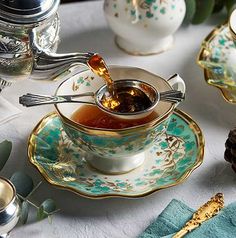
The Perfect Teacup
Share
Last week I ran a tea tasting session for a group of lovely ladies, where I supplied the teacups for the them to use. I asked the participants to choose a cup that they are drawn to. Throughout the session, I received many comments on how wonderful it was to taste the teas using a nice teacup & saucer. For me, drinking tea is always associated with a lovely teacup. I feel that the way a cup looks and feels in the hands and on the lips enhances the whole tea drinking experience. And I am definitely not a fan of mugs! As I feel that the perfect teacup is integral to the tea process as loose leaves, I thought I would find out a bit more about them.
A Quick Bit Of Teacup History
In the article 'A Short History of the Tea Servicer Set', Joelle Grubb outlines that the Chinese have been drinking tea for thousands of years, and hence were the first users of tea bowls, or ceramic cups without handles. They were bowls that could be 'cupped' in the hands, and only held small amounts of tea. It wasn't until the 17th century that saucers were invented. This provided tea drinkers somewhere to rest the cup when it became too hot for the fingers, and also a place to pour the tea to allow it to cool quicker.
On its appearance in Europe, loose leaf tea became an important part of royalty and society, and handless ceramic cups with saucers were the norm. However, as the tea was consumed at higher temperatures than in China, cups with no handles posed problems for the society ladies. A gentlemen by the name of Robert Adams saved the day by producing tea cups with handles. And as milk and sugar were often added to the tea, he made sugar bowls and milk jugs to match.
These sets were made of fine porcelain which is strong yet quite translucent when held up to the light. This was further developed by the English, who added crushed animal bone ash to the porcelain producing fine bone china, which was much more durable. To add to their attractiveness, the sets were also adorned with fine and artistic decoration, and were often trimmed with gold. As tea drinking became wide-spread, tea cups of varying grades became available.
What makes a great teacup?
So you have decided that you need to treat yourself to a beautiful teacup & saucer. What other things should you take into consideration when looking for the perfect cup?
What it is made of?
Porcelain has definitely remained the primary material from which to drink tea.This is due to its conductivity, helping to retain the ideal temperature of the tea for longer. And it leaves no lingering taste from previously held liquids, such as milk. Glass is another lovely option as you can see the colour and watch your leaves steeping and it is only marginal in not spoiling the taste. However care must be taken, as the outside of the cup can become very hot.
The thickness of the cup is also important. Cups made of thicker material tend to last longer but don't feel particular nice on the lips. Thinner pieces are the preference, as feel delicate on the lips and the tea flows better. However, they are delicate in nature and need bit more care as they have a tendency to break. Tea texture, or the way that the tea feels in the mouth, is kept better in thinner porcelain or glass.
Does size and shape matter?
The ideal is a small cup size of approximately 150ml. This allows enjoyment of stronger teas and maintains the temperature until the drink is consumed. Bigger cups may seem like a good option if you are too busy to make multiple cups of tea. The downfall is they may hold too much tea for finishing before it gets cold. In addition, they do not allow the tea to cool evenly leading to changes in its texture. For this reason, tubular cups do not give you best quality of tea infusion. Ideally the cup should be wider at the top with an even angle to the bottom, to allow the heat to dissipate evenly. ("High Tea" by Hinkler Books 2012).
Look and feel good!
Perhaps one of the most important considerations when choosing a tea cup is how it looks and feels. Of course, one of the first things that is going to draw you a particular cup is how it looks. Whether you are a fan of a certain colour, or of flowers, birds or abstract designs, it will be these things that will create that instant attraction. Then you get to know your teacup, and other things become important. In their article Teaware: the Cup - The Tea Guardian outlines that it is essential that the cup feel good to touch and use, and that you should" feel the balance lifting the cup with the handle". The handle should also be of a pleasing shape, with sufficient room for your fingers to go. It should feel comfortable to lift the cup, and not feel too heavy. And of course, the cup and saucer must fit well together. Lastly, if the cup has a little curve on the rim, it will fit better against your lips, and allow the tea to flow better.
